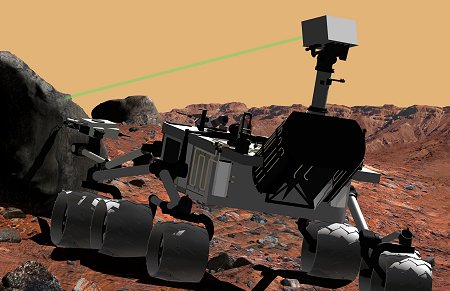NASA's rover Curiosity is expected to touch down on Mars in August 2012. Preceding the mission by a few months, its science measurements will begin much closer to Earth.
The Mars Science Laboratory mission's Radiation Assessment Detector, or RAD, will monitor naturally occurring radiation that can be unhealthy if absorbed by living organisms. Both the instrument and this type of monitoring will be firsts. It perform these functions on the surface of Mars, as well as during the trip between Mars and Earth.
 An artist's concept of Curiosity vaporizing a patch of rock for analysis. Image Credit: NASA
An artist's concept of Curiosity vaporizing a patch of rock for analysis. Image Credit: NASA
RAD has a special task and funding from the part of NASA that is planning human exploration beyond Earth orbit. RAD's measurements on Mars will help realize the mission's key goals of assessing whether Curiosity's landing region on Mars has had conditions favourable for life and for preserving evidence about life.
This information will be critical for designing human missions in space as it is expected to help assess the extent of shielding from radiation future astronauts will need. The measurements while on course between Earth and Mars, as well as the measurements on Mars, will serve that purpose.
"No one has fully characterized the radiation environment on the surface of another planet. If we want to send humans there, we need to do that," said RAD Principal Investigator Don Hassler of the Boulder, Colo., branch of the Southwest Research Institute.
Protection from the radiation environment will be necessary for space travellers. Hassler said, "The measurements we get during the cruise from Earth to Mars will help map the distribution of radiation throughout the solar system and be useful in mission design for wherever we send astronauts." Hassler's international RAD team includes experts in instrument design, astronaut safety, atmospheric science, geology and other fields.
The Earth's magnetic field and atmosphere provide effective shielding against the likely deadly effects of galactic cosmic rays and solar particle events. Mars, though, lacks a global magnetic field and has only about one percent as much atmosphere as the Earth does. RAD will monitor high-energy atomic and subatomic particles coming from the sun, from distant supernovas and from other sources. Galactic cosmic rays, coming from supernova explosions and other events extremely far from our own solar system, are a variable shower of charged particles. In addition, the sun itself spews electrons, protons and heavier ions in "solar particle events" fed by solar flares and ejections of matter from the sun's corona.These particles constitute the radiation that could be harmful to any microbes near the surface of Mars or to astronauts on a Mars mission. Astronauts might need to move into havens with extra shielding on an interplanetary spacecraft or on Mars during solar particle events. RAD measurements during the trip from Earth to Mars will enable correlations with instruments on other spacecraft that monitor solar particle events and galactic cosmic rays in Earth's neighborhood, then will yield data about the radiation environment farther from Earth.
An instrument on NASA's Mars Odyssey orbiter, which reached Mars in 2001, assessed radiation levels above the Martian atmosphere. Current estimates of the radiation environment at the planet's surface depend on the ways in which, thin atmosphere affects the energetic particles, but uncertainty in the modelling remains large. "A single energetic particle hitting the top of the atmosphere can break up into many particles -- a cascade of lower-energy particles that might be more damaging to life than a single high-energy particle," Hassler noted. The instrument was put inside major particle-accelerator research facilities in the United States, Europe, Japan and South Africa, to recreate high-enough radiation levels on Earth for checking and calibrating RAD.
The 1.7-kilogram (3.8-pound) RAD instrument has an upward-pointing, wide-angle telescope with detectors for charged particles with masses up to that of iron. It can also detect secondary neutrons coming from both the Mars atmosphere above and Mars surface material below.
Southwest Research Institute, in Boulder and in San Antonio, Texas, and Christian Albrechts University, in Kiel, Germany, built RAD with funding from the NASA Exploration Systems Mission Directorate and Germany's national aerospace research center: Deutschen Zentrum für Luft- und Raumfahrt. The team assembling and testing the Mars Science Laboratory spacecraft at NASA's Jet Propulsion Laboratory in Pasadena, Calif., installed RAD onto Curiosity last month for the late-2011 launch.
The Rover's prime mission will last a full Martian year, which is nearly two Earth years. Radiation levels may vary extremely, ranging from shorter than an hour to maybe longer than an year. Therefore a one-time set of measurements by RAD will definitely not be able to determine the radiation environment on the surface. Operational planning for Curiosity anticipates that RAD will record measurements for 15 minutes of every hour throughout the prime mission.
Radiation levels probably make the surface of modern Mars inhospitable for microbial life. The measurements from RAD will form basic datar for calculations like how deep would a possible future robot on a life-detection mission need to dig or drill to reach a microbial safe zone. For assessing whether the surface radiation environment could have been hospitable for microbes in Mars' distant past, researchers will combine RAD's measurements with estimates of how the activity of the sun and the atmosphere of Mars have changed in the past few billion years.
"The primary science goal of Curiosity is to determine whether its landing site is, or ever was, a habitable environment, a place friendly to life," said JPL's Ashwin Vasavada, deputy project scientist for the Mars Science Laboratory. "That involves looking both for conditions that would support life as well as for those that would be hazardous to life or its chemical predecessors. Natural, high-energy radiation is just such a hazard, and RAD will give us the first look at the present level of this adiation and help us to better estimate radiation levels throughout Mars' history."